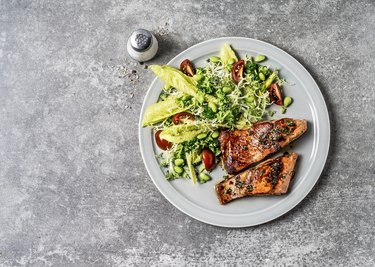Americans love their bacon. From what the Foundation For Economic Education knows, the average American eats about 18 pounds of it every year. Despite its popularity, youd be hard-pressed to find someone claim bacon to be a health food.
Bacon is high in fat, calories, and sodium, so if you like it, you should eat it in moderation. You can eat it with eggs for breakfast or on a sandwich for lunch or dinner.
Bacon is a beloved breakfast food for many, known for its savory, smoky flavor and crispy texture when pan-fried. However, bacon is also high in fat and calories. This leads some bacon lovers to wonder – can you reduce the calories in bacon by cooking out some of the fat?
This is a controversial topic without a definitive scientific answer. However, based on available research and expertise, it seems unlikely that a significant amount of calories are lost when cooking bacon.
The Calorie Content of Raw vs Cooked Bacon
According to the USDA, a slice of pork bacon (raw) contains 43 calories and 3.5 grams of fat. Once cooked, the same slice contains 36 calories and 3 grams of fat.
At first glance, this makes it appear that cooking bacon reduces its calories and fat content However, nutrition labels are allowed up to 20% margin of error for calorie counts So the small difference between raw and cooked bacon could simply be within the accepted variance.
Overall, cooking bacon renders out some of the fat. But the amount is small in proportion to the total fat content. So any calories lost are negligible.
The Fat That Renders Out Still Contains Calories
When bacon is cooked, some of the fat melts off into the pan. This rendered fat is still edible and contains calories.
The amount of fat that renders out depends on the cooking method. Frying bacon leads to more fat rendering compared to baking
But either way, most of that fat remains in the pan and can be absorbed by anything else cooked in it. Unless you meticulously pour off and discard hot grease after cooking, those calories aren’t really lost. They just transfer to other foods.
Studies on Cooked vs Uncooked Meats Show Minimal Calorie Difference
Several small studies have analyzed the calorie differences between raw and cooked meats. The results show that cooking only reduces calorie content by 0-15%.
Specifically for bacon, one study found pan-fried bacon retained 84% of its original calories after cooking. Other cooked meats like hamburgers and sausages retained over 90% of their raw calorie amounts.
While bacon may lose more fat than other meats when cooked, the overall calorie reduction is still fairly small. Nowhere near the 50% or greater reduction some people expect.
Fat Loss Depends on Cooking Method and Bacon Type
How much fat renders out of bacon depends on two main factors:
-
Cooking method: Frying bacon leads to more fat rendered out compared to baking or microwaving. So fried bacon may have slightly less fat than bacon cooked other ways, but the difference is minor.
-
Bacon type: Thinner bacon slices render out proportionally more fat than thick-cut styles. Bacon from different cuts (belly vs back, etc) also releases varying fat amounts. So the starting fat content affects final calories.
But for most standard pork bacon slices, these factors cause less than a 20% calorie difference between raw and cooked.
Should You Drain Bacon Fat to Reduce Calories?
Pouring off grease after cooking bacon does eliminate some calories from absorption. However, this doesn’t change the actual calorie content of the bacon itself.
Bacon still retains most of its fat and calories after cooking. Draining off extra grease really only helps avoid the additional calories it contributes to other foods.
So draining fat is an effective way to create lower calorie recipes. But the bacon itself will still have nearly the same calories as it would have if you kept the grease.
Why It Seems Like Bacon Loses More Fat Than It Does
When bacon shrinks in size and you pour off grease, it’s easy to assume a large portion of calories was lost. But keep in mind:
- Water loss accounts for most bacon shrinkage, not just fat.
- The rendered fat still contains calories if absorbed.
- Fat is calorie-dense, so a small amount retains a lot of calories.
So while the visual fat loss seems high during cooking, the actual calorie reduction is fairly minor.
Nutrition Facts Account for Cooked Calories
Nutrition labels on bacon account for any calories lost during cooking. So the calories listed are for cooked bacon, not raw.
This means cooking your bacon as directed will provide the calories shown. You don’t need to further adjust for any fat rendered out during cooking.
Of course, these labels still allow for up to 20% inaccuracy. But any variations would be small and not worth tracking.
Should You Choose Turkey Bacon for Less Fat?
Many people assume turkey bacon must be lower calorie than pork bacon. However, reads labels carefully.
Turkey bacon contains less total fat – about 25% less. But it’s still high fat considering the small serving size. A slice of turkey bacon contains around 30 calories and 2g fat.
So turkey bacon doesn’t automatically make sense for limiting calories. It can work if it fits your tastes and diet better than pork. But don’t swap it blindly assuming it’s a lower calorie option.
Tips to Reduce Calories from Bacon
If you’re concerned about bacon’s calories and fat, these tips can help balance it in your diet:
- Choose center-cut bacon with visibly less fatty areas.
- Opt for turkey bacon or prosciutto for slightly less fat than pork.
- Cut slices in half or thirds to keep portions small.
- Limit bacon as a side dish and use it more as a flavoring in recipes.
- Drain bacon grease thoroughly after cooking and don’t reuse it.
- Bake bacon on a rack instead of frying to reduce overall fat.
The Bottom Line
Cooking bacon does render out some fat, but the actual calorie reduction is fairly small. Anywhere from 0-15% of calories are lost once bacon is cooked.
For most recipes, it’s not worth worrying about the precise calorie difference between raw and cooked bacon. Just be mindful of your portion sizes and cooking methods to better control bacon’s calories and fat.
At the end of the day, bacon is a high-calorie, high-fat food. While cooking it may help slightly, bacon is always going to be a indulgent treat food regardless of preparation method. Enjoy it in moderation as part of an overall balanced diet.
:max_bytes(150000):strip_icc()/bacon_annotated2-1efa80033a7f4f9ebb9fb187773aafe7.jpg)
What Is Canadian Bacon vs. American Bacon?
Canadian bacon (which is just called “bacon” in Canada) comes from the loin of the pig — behind the shoulder — while regular American bacon comes from the pig belly, per Berkeley Wellness.


Canadian bacon, ham and regular bacon are all cured meats. Canadian bacon is usually sold fully cooked and has less fat and fewer calories than conventional American bacon.
You can see below that a single slice of Canadian bacon has less fat and calories than regular bacon, but it still has a lot of sodium. This is important to keep in mind when deciding how many slices to add to your plate.
Nutrition and Calories in Bacon
One slice of raw, cured pork bacon, equal to 28 grams, contains:
- 110 calories
- 10.4 g fat
- 3.5 g saturated fat
- 210 mg sodium
- 0 g carbohydrates
- 4 g protein
Calories in Crispy Bacon
One 12-gram slice of pan-fried, crispy bacon contains 54 calories and 4 grams of fat — less than raw bacon because the fat cooks down.

